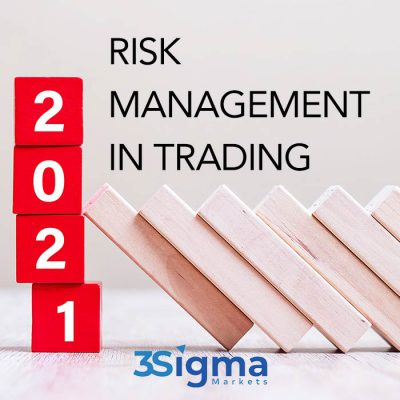
Trading is a risky endeavour regardless of the experience of the trader or the reliability of the trading system. There is a high chance that a trader can lose all of their capital in the financial markets. So a trader needs to protect themselves in order to maintain their account balance and keep momentum moving forward. Every trader wants to grow their account and achieve their targets. Traders should approach trading as a business and every business needs to conduct a risk analysis and create a business plan. Traders should do this by creating a trading plan and figure out how they are going to trade. If this is done correctly the trader will quickly realise that to treat trading as a business they need to divide their plan into what they can and cannot control. Traders can control the three basic parts of a trade, 1. how much they risk, 2. where they enter the market, and 3. where they exit the market.
How to calculate a stop loss
If we assume that the trader will only risk 1% of their capital on a trade, we then have to calculate how much to risk based on the size of the stake and the distance to the stop loss. If 1% of a traders account is equal to £10 and they use a £1 stake size per pip, they can risk 10 pips and set their stop loss 10 pips away from their entry. The trader has now limited their risk to 1% of their account. It doesn’t have to be 1% but this is a safe amount to risk on a trade. The trader is now controlling how much they are risking, where they entered the market and where they are going to exit if they market moves against them. They will of course have to decide where to exit the trade for a profit.
In the example above, the trader could have risked the same amount of 1% or £10, but halved their stop loss to 5 pips. This would mean that they use a £2 per pip stake size and if the market moves 5 pips against them they would be stopped out.
Traders should use a stop loss all of the time on every trade. This is a best practice approach and helps to maintain the trader’s discipline. There are two kinds of stop loss to discuss. The first type is a “mental stop loss”. This is where a trader decides on a stop loss level where they will close the trade, but they do not use a physical order in the market. The disadvantage with this type of stop loss is twofold. Firstly the traders may need to step away from the screen or there may be a power cut or the internet connection may go down preventing the traders from closing the trade at the mental stop loss. The trade may run also overnight and the price has the potential to gap past the stop loss level while the trader is asleep. The second disadvantage with a “mental stop loss” is that the trader may simply ignore the price moving past the level and let the trade run deeper into losing territory. This can lead to a far bigger loss that initially accounted for. Trader may be tempted to hope that the trade will turn around in their favour and prevent them taking a loss. This should be avoided at all cost.
The second kind of stop loss is when a trader places a market order to close the position when it hits the levels. This takes the emotion out of the trade and allows the traders to concentrate on something else instead of having watching the trade. As long as the trader doesn’t adjust the stop loss level, the trade will close when it is hit. A trader may wish to adjust the level when they are trading in the direction of the trend and they wish to reduce risk by placing their stop loss into profit. In this way a trader can move their stop further and further into profit as the trend continues greatly increasing their profits. There is a way that a trader can automate this process by using a trailing stop loss. This is a market order that is not fixed at a level but is fixed a certain distance from the entry. As price moves further from the entry level in the direction of the trend, the stop loss follows the price. But when the price goes against the trend the stop loss stops moving locking in the profit or limiting the loss at the new level. A trailing stop loss will only move in the direction of the trade.
How does a trader work out where to place the stop loss?
A trader has a number of ways to use a stop loss. The most basic is placing a stop a fixed distance from the entry. This can be 30 pips or 100pips away for example. This is a very blunt way of implementing a stop loss and takes no account of where support and resistance may be. A trader may base their stop loss position on a calculated number of pips from their entry level, so that they only risk a percentage of their account. This method is a little bit more advanced but again fails to take account of support and resistance for example. This is knows as a percentage stop.
A Chart stop loss is used when a trader bases the position of their stop on a technical chart level. This can be in the form of support and resistance, Fibonacci levels or trend lines for example. A trader will assess the chart to locate a likely trade and place the stop level based on where that trade becomes invalid. This may take the form of place the stop above the highs of a double top pattern. In this instance if price moves above the double top, then the pattern is no longer a double top pattern and something else is happening, thereby invalidating the trade. If a trade is invalid then the trader would wish to be taken out of that trade and a stop loss fulfils this function perfectly.
A trader may wish to use a timed stop loss, so that the position is closed at the end of the day or ahead of the weekend. A day trader would want to be out of their trades before the market closes and they would exit their trades before this happens. This stop is best combined with one of the other types of stops.
The trader may also place their stop based on how volatile the market is. The trader may not want to be stopped out of a good trade setup if volatility picks up. This is allowed as long as the volatility does not exceed the traders risk tolerance. A volatile market could see price make relatively large swings compared to more usual trading conditions. Volatility can be raised for a number of reasons. There are a number of ways of measuring the level of volatility in a market. One of these ways is to use an indicator called the ATR, which stands for Average True Range and measures the average range of a market over a certain timeframe. When volatility increases the range increases and traders can place their stop outside of this range to avoid being stopped out by the market noise.
Traders should always use a stop loss when they trade, preferably one using a market order to remove them from the trade in the cases of unforeseen events. A stop loss should always give the trader a risk/reward ration greater than 1. A 1:3 risk/reward ratio means a trader risks £1 to make £3. Stop losses are the most important risk manage tool a trader can employ. They are an extremely effective way of limiting losses and controlling emotions. This helps to preserve the trader’s financial and emotional capital and it is a keystone on the path to success.



